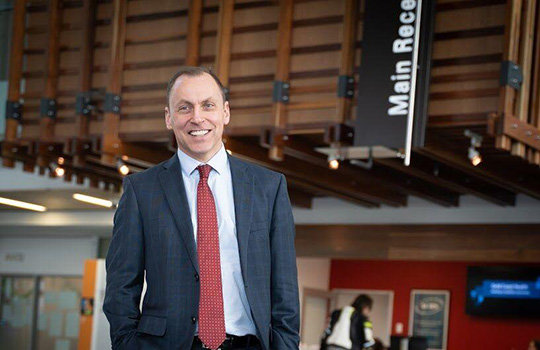
“One of the things the pandemic has imposed on health organisations pretty quickly is the need to be working in a very agile manner. You need to have a good focus on problem and issue definition and be able to ideate very quickly in terms of a response to a particular solution.”
FST Government: On the front lines of the pandemic response, government, and in particular healthcare services, have faced enormous pressure to deliver in times of surging demand (both expected and real). Take us through some of the standout challenges facing public agencies right now, both in Queensland and more generally.
Green: From a healthcare industry perspective, Queensland Health plays a leading role in managing the state’s response to the pandemic. One of the key things we have to do is manage the immediate impact on public health and the rapid response necessary to deal with that. The pandemic has placed severe stress on our ability to mobilise staff adequately and to ensure that they are trained to manage something so volatile and new whilst we introduce new practices to support the delivery of best care to the population. That’s number one.
Number two is managing the impact on both staff and facilities; this pandemic environment challenges the healthcare industry directly and imposes stress on our people. We are an organisation that is concerned with people and care, so managing the ability of our staff to cope in this environment for a sustained period is going to be critical for our success.
The third issue impacting us and requiring immediate response is the extreme volatility of the world around us. We’re seeing massive disruption to supply chains and potential shortages breaking out, not because of the risk of the disease itself but because of the fear that people have. This is driving a particular response within the community and we now have to manage the shortages of essential clinical supplies to keep caring for our organisation.
The fourth area is organisational impact: maintaining an instant command centre for the pandemic, ensuring that we undertake rapid expansion of telehealth and virtual care services and enabling remote work.
There is an increasing emphasis on operating discipline; now is the time for us to operate and act as an agile organisation and to respond to the challenges being imposed on us. At the same time, we need to ensure that we’re not forgetting that routine things matter – security and managing investments – so people are supported and our assets are safe.
FST Government: Once approached with scepticism – potentially even derision – by managers, ‘work-from-home’ has very quickly become the new working norm. What organisational tactics and processes have QLD Health deployed to better support the demands of remote workforces?
Green: One of the things the pandemic has imposed on health organisations pretty quickly is the need to be working in a very agile manner. You need to have a good focus on problem and issue definition and be able to ideate very quickly in terms of a response to a particular solution. So, for instance, in terms of virtual working and the need to offer that service rapidly, we have to expand and scale that service. To do this, we’ve had to think outside the box, but we haven’t focused on one strategy in terms of delivering that. We’ve implemented several solutions: for example, we’ve devised multiple ways for clinicians to work in a virtual care system, and other ways for our frontline office workers to operate in a remote situation with multiple technology tools.
The key for us has been in understanding the use case and the problem we’re trying to solve for that particular client, and then being comfortable using agile delivery techniques to get it to spin up a solution. It’s not necessarily the perfect solution, but it’s about getting a solution up and being able to iterate – and that’s exactly what we’re doing. The second part of that is the importance of service continuity planning right from day one. When we realised Covid-19 was accelerating into a pandemic, we rewrote our business continuity plans and had our organisation practising them. All staff within Queensland Health have been delivering a message around the importance of practising in a remote working environment and figuring out what works for them – and ensuring teams are learning how to support each other in this environment. It’s not only about working as an individual, but also practising to remain connected and to develop the operating mechanisms that you need as a team to work in a virtual capacity. All these things need to be built into the continuity service plan. It poses a new responsibility on managers and team leaders to assure that you’re working with and enabling your teams to practice in this environment. And if you go in thinking you’ll get it right first time, you’ll be sorely disappointed. It takes practice, and there is no perfect solution to it.
FST Government: What can be done to change the culture around accepting that staff can work from home and still be productive? Are there learnings that we’ve already gained since the initial lockdown in March?
Green: I had a discussion with a manager the other day who was a bit concerned about letting his staff go to work from home, and the concern he raised was: ‘Well, if they’re at home and working, I can’t necessarily see them and I can’t manage them, so how do I know that they’re going to be productive?’. I thought about the response and, really, if that’s the situation, you’ve probably got that problem in the workplace today. Most of the people in our organisation are self-motivated and self-enabled. But the issue that we’ve had in our organisation is finding the time to practice and design a way of working that suits the team and the workplace. They’re not all the same, so if you work on an infrastructure maintenance team, your needs are quite different to, say, working in a client representative team.
These routines and processes need to be practised in addition to using the technology itself. Indeed, some people might find that it’s not so much the video that’s important in their way of working, it’s the humble telephone that becomes more important. So, it does depend on the particular use case in context, and it emphasises the importance of good practice as part of continuity service planning.
FST Government: Increasingly, government agencies are shifting resources to cloud, with servers often housed beyond the jurisdiction of Australian regulators. Do you see these offshore servers as a problem for security in the environment in which the public sector operates?
Green: We’ve put a lot of effort into working with our partners who provide cloud services to us. I think the bigger risk is in scaling our own internal infrastructure across the state to be able to manage the working environment. Particularly in our state of Queensland, the risk I see is for our telecommunications infrastructure, particularly in rural and remote regions, in being able to promote a digital way of working. We need to ensure that the underlying communications infrastructure across the state is enabled to support that way of working and not creating a digital divide.
FST Government: How do we ensure that we are leveraging the right tools and resources to support employee collaboration, communication, and productivity?
Green: It’s a good question. It’s one that we focused on right at the start of Queensland Health’s planning for this journey. Our question was ‘How do we enable our clinicians to continue to provide care to patients that they might not be able to physically touch?’ and, moreover, ‘What are the ways that we need to provide solutions to enable them to do that?’. The critical thing and lesson learned for me in this process has been the importance of knowing my place as a chief information officer: to be a service provider, but also to be very well connected with the users on the front line in terms of understanding what they need, letting them communicate the problem that needs to be solved, and then facilitating the process of how they’d like the solution to support that problem. One example would be our existing telehealth network, which was really good, but one of the challenges for remote working is that you need a named login and you need to be connected into Queensland Health infrastructure to be able to support ‘teleworking’, if you like. That’s not always feasible for our clinicians who are on the road and particularly remote working, and they really raised the bar in terms of helping us understand that we needed to provide a better web-enabled offering, which in turn enabled them to essentially, in one click, log in and be able to remote dial in to our patients’ appointments – so, a clinician can now work in their home and offer a service or advice to a patient in their own home; that wasn’t possible before we entered this pandemic. Overall, it was really ensuring that the use case was defined by clinical teams and then making sure that we iterated or spun up a solution that might meet them halfway and improve upon it. This business-led ideation has been critical in terms of helping us answer this question.
FST Government: Collaboration is often seen as the conduit to innovation. What are some of the in-agency conversations we’re seeing on furthering collaboration between private and public sectors?
Green: There’s a lot going on and it’s in managing those requests that are coming in from the private sector – which has been very helpful in supporting our response to the crisis – that’s been the key part of my role and my leadership team’s role. One of the things that we’re finding is the ability to keep up with the ideas coming in from industry, to support us in our work, and link them to the right problem and the right people in the field, is a key aspect of our work and focus. This really builds upon the discussion around how an organisation goes about supporting innovation.
We’re doing innovation at scale in this pandemic, so it’s really pushing us to focus on how we industrialise that process. Apart from that, I’d just like to pass on my thanks to the communities who are supporting us.
FST Government: What is the key to successfully adapting the way we work in government, not only to deal with the current crisis but also any future crises likely to arise?
Green: Adaption requires problem definition. It requires planning and practice. That’s the mode of operating that Queensland Health, and particularly eHealth, are working through. I’ve never seen such rapid innovation and deployment of new solutions occur in such a short period of time. But it doesn’t just happen out of luck – it happens because the team is very engaged with the client to understand what the immediate problems are that need to be solved, carefully prioritising them, and then working in a very agile manner to provide the solutions and support the organisation to practice and apply. That is the key mode of working that we are adopting as an organisation to support us through this pandemic.
————————————————————-
This is an edited extract from FST’s virtual panel, Adapting to the New Ways of Working in the Times of a Global Pandemic: The Public Sector Perspective, hosted on 1 April, featuring exclusive insight from Damian Green, CIO, QLD Health.





